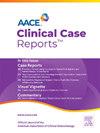接受静脉免疫球蛋白治疗的女性甲状腺乳头状癌患者抗甲状腺球蛋白抗体异常
IF 1.2
Q3 Medicine
引用次数: 0
摘要
背景:甲状腺球蛋白和抗甲状腺球蛋白抗体用于分化型甲状腺癌的监测。分化型甲状腺癌患者需要静脉注射免疫球蛋白治疗自身免疫或恶性疾病,抗甲状腺球蛋白抗体的监测具有挑战性。我们报告一例甲状腺乳头状癌患者,在接受静脉注射免疫球蛋白时,其抗甲状腺球蛋白抗体水平波动。一例41岁女性,因多灶性甲状腺乳头状癌行甲状腺全切除术、中央及左侧改良颈部清扫术及放射性碘消融术治疗。该癌表现为嗜瘤性及warthin样变异,28例左侧淋巴结中1例及10例中央淋巴结中1例转移。十年后,她感染了COVID-19,并患上了COVID-19相关脑病,为此她接受了7个月的静脉注射免疫球蛋白。静脉注射免疫球蛋白5个月后,甲状腺球蛋白监测值为0.8 ng/mL(液相色谱-质谱联用法,0.4 ng/mL),抗甲状腺球蛋白抗体从检测不到增加到97 IU/mL(化学发光免疫法,≤1 IU/mL)。在最后一次静脉注射免疫球蛋白后,抗甲状腺球蛋白抗体水平逐渐下降,治疗6个月后达到1 IU/mL(化学发光免疫测定,≤1 IU/mL)。颈部超声检查未见疾病复发。由于供体抗体(包括抗甲状腺球蛋白抗体)的被动转移,静脉注射免疫球蛋白可影响分化型甲状腺癌患者的监测。该患者新检测到的抗甲状腺球蛋白抗体可能是由于通过静脉注射免疫球蛋白检测到供体抗甲状腺球蛋白抗体,而不是癌症复发。结论分化型甲状腺癌患者接受静脉注射免疫球蛋白治疗时,在新检出抗甲状腺球蛋白抗体时应考虑供体是否存在抗甲状腺球蛋白抗体。本文章由计算机程序翻译,如有差异,请以英文原文为准。
Abnormal Antithyroglobulin Antibody in a Woman With Papillary Thyroid Carcinoma Receiving Intravenous Immunoglobulin Treatment
Background
Thyroglobulin and antithyroglobulin antibodies are used in the surveillance of differentiated thyroid carcinomas. In patients with differentiated thyroid carcinoma who require intravenous immunoglobulin for autoimmune or malignant conditions, surveillance of antithyroglobulin antibodies is challenging. We present a case of a patient with papillary thyroid carcinoma who showed fluctuating antithyroglobulin antibody levels while receiving intravenous immunoglobulin.
Case Presentation
A 41-year-old woman underwent total thyroidectomy, central and left modified neck dissection, and radioactive iodine ablation for multifocal papillary thyroid carcinoma with features of oncocytic and warthin-like variant and metastasis to 1 of 28 left lateral and 1 of 10 central lymph nodes. Ten years later, she contracted COVID-19 and developed COVID-19-associated encephalopathy for which she received intravenous immunoglobulin for 7 months. Five months after intravenous immunoglobulin initiation, surveillance thyroglobulin was <0.8 ng/mL (liquid chromatography with mass spectrometry, <0.4 ng/mL) and antithyroglobulin antibodies increased from undetectable to 97 IU/mL (chemiluminescent immunoassay, ≤1 IU/mL). After the final intravenous immunoglobulin dose, antithyroglobulin antibody levels progressively decreased, reaching 1 IU/mL (chemiluminescent immunoassay, ≤1 IU/mL) 6 months posttreatment. Neck ultrasounds showed no evidence of disease recurrence.
Discussion
Intravenous immunoglobulin can affect monitoring of patients with differentiated thyroid carcinomas due to passive transfer of pooled donor antibodies, including antithyroglobulin antibodies. Newly detectable antithyroglobulin antibodies in this patient were likely due to measured donor antithyroglobulin antibodies via intravenous immunoglobulin rather than cancer recurrence.
Conclusion
In patients with differentiated thyroid carcinomas receiving intravenous immunoglobulin, the presence of donor antithyroglobulin antibodies should be considered when antithyroglobulin antibodies are newly detectable.
求助全文
通过发布文献求助,成功后即可免费获取论文全文。
去求助
来源期刊

AACE Clinical Case Reports
Medicine-Endocrinology, Diabetes and Metabolism
CiteScore
2.30
自引率
0.00%
发文量
61
审稿时长
55 days
 求助内容:
求助内容: 应助结果提醒方式:
应助结果提醒方式:


